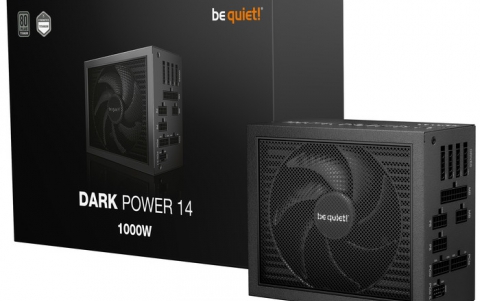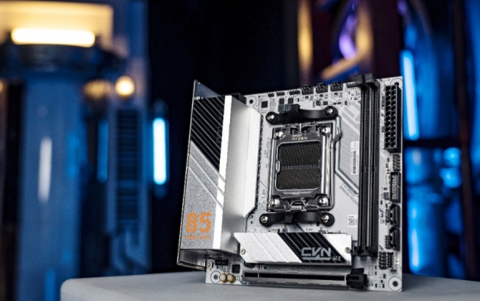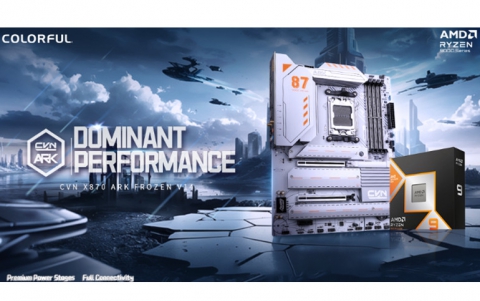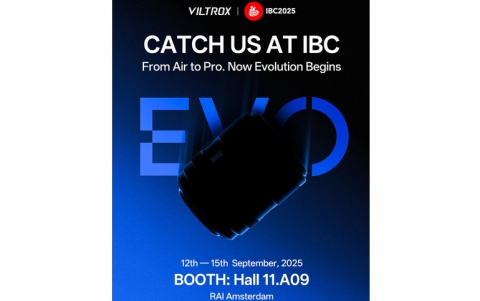Yamaha CRW2200E CD-RW
1. Features
Yamaha CRW2200E IDE CDR-W - Page 1
- Introduction:
 Yamaha
has been a leader in CD-Recording for many years. After some hard years, Yamaha
got the leadership with the shipment of the first 16x (P-CAV) recorder back
in November of 2000. After the shipment of 16x (CLV) writers, Yamaha announced
in March of 2001 a new series of recorders with the code name "2200",
which supported 20x writing, 10x re-writing and 40x reading. In the same time
period Ricoh and Sanyo had announced similar/faster recorders, which also supported
the same specs but realized them with a different approach in technology. The
battle has started for the best/faster recorder ever! Who will win? Who offers
the most solid ultra high speed recorder?...
Yamaha
has been a leader in CD-Recording for many years. After some hard years, Yamaha
got the leadership with the shipment of the first 16x (P-CAV) recorder back
in November of 2000. After the shipment of 16x (CLV) writers, Yamaha announced
in March of 2001 a new series of recorders with the code name "2200",
which supported 20x writing, 10x re-writing and 40x reading. In the same time
period Ricoh and Sanyo had announced similar/faster recorders, which also supported
the same specs but realized them with a different approach in technology. The
battle has started for the best/faster recorder ever! Who will win? Who offers
the most solid ultra high speed recorder?...
- New features:
![]() The
Yamaha 2200x series support 20x writing (P-CAV), 10x re-writing (CLV) and 40x
reading (CAV). The competition from Ricoh and Sanyo achieves high-speed recording
with the adoption of Zone-CLV writing. On the other hand Yamaha continues to
believe that the P-CAV writing technology, as introduced in the 2100x series,
is the future...
The
Yamaha 2200x series support 20x writing (P-CAV), 10x re-writing (CLV) and 40x
reading (CAV). The competition from Ricoh and Sanyo achieves high-speed recording
with the adoption of Zone-CLV writing. On the other hand Yamaha continues to
believe that the P-CAV writing technology, as introduced in the 2100x series,
is the future...
 The
P-CAV method keeps disc rotation constant in the inner portion of the disc as
writing speed smoothly accelerates outwards until it reaches top speed. After
that, writing speed is kept constant (CLV) until the end of the writing.
The
P-CAV method keeps disc rotation constant in the inner portion of the disc as
writing speed smoothly accelerates outwards until it reaches top speed. After
that, writing speed is kept constant (CLV) until the end of the writing.
In the P-CAV method, the rotation speed is kept moderate (5500 rpm) in the inner portion of the disc, compared with CLV method (over 9000 rpm at the beginning of the disc by 20X CLV). That helps improve the quality of write in the inner portion of the disc, because moderate disc rotation reduces the vibration that corrupts quality. Also since the rotation speeds are low the life of the laser diode and the drive's pickup will be extended.
 On
the other hand
On
the other hand
Z-CLV recording method utilizes the existing CLV method combined with linking
technology developed for buffer underrun protection. The writing of a disc is
divided into several zones, and writing speed is kept constant within each zone.
When it shifts up to the next speed, writing is suspended and then restarted
using the buffer underrun protection.
As you can understand in the Yamaha's P-CAV writing technology there isn't any link. Yamaha believes that P-CAV is: "...Ideal for Audio CDs and pre-mastering a disc for mass duplication...".
- New Technologies:
The Yamaha CRW2200 series has mainly one new big technology with the codename: "SafeBURN".
![]() is
actually a series of different technologies which are combined in order to give
recording protection system that not only avoids buffer underrun, but ensures
the written disc is of the best possible quality, even at the fastest recording
speeds.
is
actually a series of different technologies which are combined in order to give
recording protection system that not only avoids buffer underrun, but ensures
the written disc is of the best possible quality, even at the fastest recording
speeds.
SafeBURN is the concept for error-proof CD recording, which includes (but is not limited to) Buffer Underrun Protection, 8MB buffer and Optimum Write Power Control. That means triple security with 8 MB Buffer, Buffer underrun protection and Optimum Write Speed Control. SafeBURN system, employs Oak Technology's buffer underrun protection method in the DSP and is integrated with Yamaha's own chips to achieve the highest accuracy of highest level of data continuity possible. The following graph shows how the technology works:

When data transfer is delayed and memory in the buffer drops to a critical level, recording is suspended until the buffer has regained sufficient memory, after which the recording restarts virtually seamlessly from the point at which it was suspended. The link is done at the same speed of writing. If you are writing at 20X, then the link is done at 20X. According to Yamaha the gap length between the 2 links is below one micrometer, (not measurable). Sanyo has said that the latest build of "BURN-Proof" also has no gap length (found in BP1400P series) and as for Ricoh's "Just-Link" there isn't any change in the 2-5 micrometers of gap length.
- 8MB of Buffer:
The Yamaha 2200x series are equipped with an 8MB buffer memory. You might
think why Yamaha has added 8MB of buffer, when other manufacturers have only
2MB of buffer with their recorders.
The answer ,according to Yamaha, is that: "...minimizes the incidence of buffer underrun in cases where the CPU of the host PC is not fast enough and other applications are running while writing. Frequent activation of buffer underrun protection increases the time required for the completion of disc writing, because the drive has to seek for the linking point every time. Too many occurrences of buffer underrun devalues the essential nature of high speed drives. In addition, even if buffer underrun protection can make virtually seamless links, a disc with no links is more desirable than one that is full of links..."
What Yamaha states is true... If you try to burn a CD while getting many buffer underrun the total recording time is higher than in case you don't have zero buffer underrun. However in cases such as CD to CD copy (on-the-fly), the 8MB of buffer will not save the "link" between the 2 broken parts..For normal applications and with the proper CDR software, the 8MB of buffer work smooth and avoids un-necessary links.
- Optimum Write Speed Control:
The Optimum Write Speed Control function that automatically adjusts writing
speed to the optimum level for each kind of disc. Simply by setting the writing
speed at 20X, the CRW2200 checks the characteristics and conditions of the inserted
disc and automatically selects the maximum optimum writing speed for the disc
to ensure data reliability when the disc is read back by CD-ROM drives or CD
players.
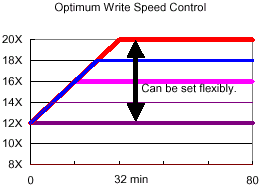 Plextor,
Sanyo and Ricoh have similar systems with can drop down writing speed. Due to
the lack of P-CAV technology other drives can only reduce the speed from 24x
to 20x or 16X (all speeds are CLV) while Yamaha's Optimum Write Speed Control
can set the maximum writing speed more flexibly, at 20X, 19X, 18X, 17X, 16X,
12X and 8X
Plextor,
Sanyo and Ricoh have similar systems with can drop down writing speed. Due to
the lack of P-CAV technology other drives can only reduce the speed from 24x
to 20x or 16X (all speeds are CLV) while Yamaha's Optimum Write Speed Control
can set the maximum writing speed more flexibly, at 20X, 19X, 18X, 17X, 16X,
12X and 8X
The Optimum Write Speed Control is enabled by default but you can be turned
off within the recording software. If the drive finds the recording quality
good it can  rise
up the recording speed from 12x up to 20x (which however we must note never
witnessed). With the Nero software you can notice the speed dropdown since a
warning message appears (among with the increased writing time).
rise
up the recording speed from 12x up to 20x (which however we must note never
witnessed). With the Nero software you can notice the speed dropdown since a
warning message appears (among with the increased writing time).
- Universal design of interface variation:
The Yamaha with the 2200x series introduced a revolutionary idea.... All
CRW2200 series models are based on the same ATAPI drive. Using interface bridge
adapters specially engineered by Yamaha, the 2200 series can be connected to
a several of different interfaces (SCSI, FireWire, USB 2.0) making all users
happy. Also the production cost is less now since the Yamaha develops only one
model (IDE) instead of multiple. The idea is very clever and we hope that other
manufacturers will follow it in order to produce a full series of interfaces
(including long requested SCSI recorders):
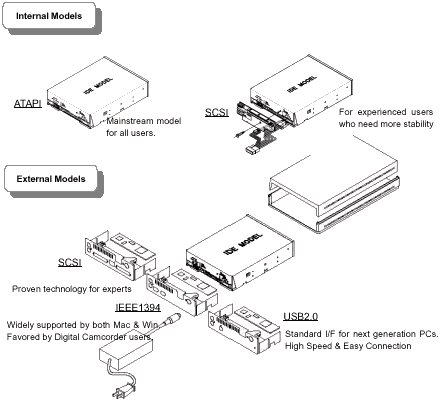
The CRW2200 series features five models to meet users' needs: CRW2200E (internal ATAPI), CRW2200S (internal SCSI-3), CRW2200SX (external SCSI-3), CRW2100IX (external IEEE1394), and CRW2200UX (external USB1.1/2.0).

